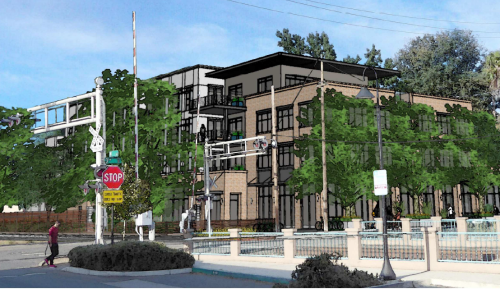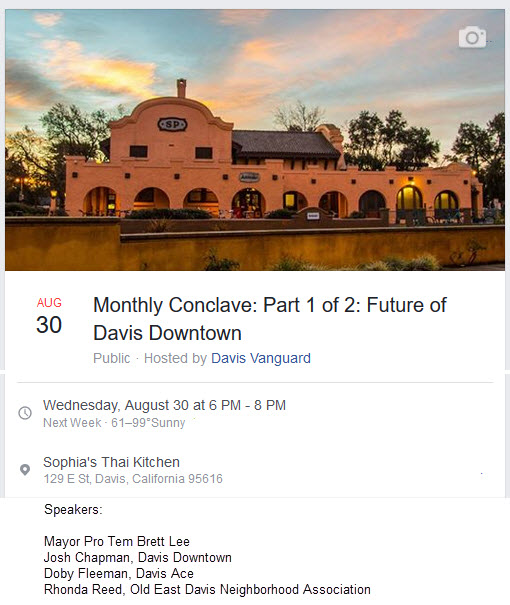
The Vanguard has been an equal opportunity critic lately of the planning process. The Vanguard was very critical of the Planning Commission for its handling of B Street, where it seemed to reject a project that met all of the major zoning standards with less than 15 percent variance on height on a small portion of the project.
On the other hand, we believed the staff did a good job in laying out the exact duties of the Planning Commission when considering the MRIC (Mace Ranch Innovation Center) EIR certification.
It is hard to fault the Planning Commission for their ultimate actions on Wednesday night, although perhaps instead of recommending against approval of the Initial Study and Design Review, the commission should have simply punted altogether and said they lacked information to make a specific recommendation – that’s essentially what they did anyway, but any criticism there would be splitting hairs.
The Planning Commission got the message from council that council wants to densify in order to meet the city’s housing needs. Probably five of the seven commissioners at the meeting liked the project.
However, staff, rather than agreeing to come back in a few weeks with more information as requested by the commission, pushed through for a decision, and they got one – rejection.
Ash Feeney said on Wednesday that the “guidelines describe a preferred policy direction but are intended to provide flexibility.” He argued that the “project is substantially consistent with Design Guidelines.”
But the commission wasn’t buying it. The problem that the city faces is that the combination of General Plan, Specific Plan, Guidelines and Zoning has overlapping and at times contradictory  rules. The Vanguard has been begging the council and staff to delay consideration of this project until the city can figure out the Core Area Specific Plan (that is one of our goals for next Wednesday’s discussion).
rules. The Vanguard has been begging the council and staff to delay consideration of this project until the city can figure out the Core Area Specific Plan (that is one of our goals for next Wednesday’s discussion).
Without clear guidelines, the process is unfair to everyone – that includes neighbors who do not have reasonable expectations as to what possible future projects will be and developers who have to anticipate what the council and Planning Commission are willing to accept.
I share a lot of the views expressed by the Planning Commission, but I have a good deal of problem with the way staff has decided it needs to resolve the conflict.
 Staff has argued, “The Design Guidelines must be considered as part of a project review, but do not establish mandatory requirements in contrast to Zoning standards which are mandatory.”
Staff has argued, “The Design Guidelines must be considered as part of a project review, but do not establish mandatory requirements in contrast to Zoning standards which are mandatory.”
In effect, the guidelines are guidelines, which has made commissioners and others question, if we do not have to follow guidelines, why have them in the first place?
At the very least, the rules established need to have internal consistency and staff needs to enforce them consistently. That has not happened.
To make the matter more confusing, there is language in the Municipal Code that says, “Wherever the guidelines for the DTRN [Downtown and Traditional Residential Neighborhood] conflict with the existing zoning standards including planned development, the more restrictive standard shall prevail.”
The commission felt like the guidelines were pretty clear in terms of height limitations and were not willing, on the basis of the opinion of the assistant city attorney, to approve the design review.
As Stephen Mikesell, who was in the minority in terms of more general opposition to the project, noted, the city council should “give serious thought to revising those guidelines if they are going to be treated as though they are simply suggestion, then the people affected by those guidelines need to know that.”
Mr. Mikesell said, in the hotels discussions, they were accused of “mutilating the zoning, where the zoning was squishy on those.” He said “in this case, the zoning is not squishy, the zoning is very clear as to what the height limitation is on these.”
Marilee Hanson, the vice chair, who chaired the meeting, said, “The guidelines mean something. They’re the rules, they’re the standards. We should require people to abide by them or get rid of them.”
She also cited a “pattern here,” where “we’re constantly brought these things with inadequate information and we’re told that the city council really wants our opinion.
“I don’t think that the way that the city has to go is constantly breaking the rules in order to get more housing,”
This is of course all an academic exercise. The neighbors have legitimate beefs on several points along the way here. One was the initial approach to the project and outreach by the developer. A second may be the unreasonable six-story building proposal that clearly was never going to fly. And finally there was the cavalier attitude by the staff toward guidelines, also in terms of their willingness to work with the Planning Commission here.
Again, I have been critical of the Planning Commission in the past – I have no skin in this outcome and do not have a clear preference for project or no project.
However it seems like we should at least have a consistent process and consistency across planning documents – which we do not have right now.
All this said, the neighbors should not get their hopes up about the outcome in this case. In the end, the council will vote to support a project here. I may have questions about the lack of number of units and the type of units they will be, but having a mixed-use project that can generate business while housing some people is probably a net plus, even with serious impacts on the neighbors.
The only real question is what the building height will be. Whether the council decides to push for three stories rather than four remains to be seen.
Council will have to determine whether three is the magic number or not.
My own preference, given the need to build upward, is probably to push still for four stories, even though I expect council will decrease the size and massing in deference to the concerns of the neighbors.
The other issues need to be resolved quickly, however, as they are more serious from a policy standpoint.
—David M. Greenwald reporting







“All this said, the neighbors should not get their hopes up about the outcome in this case. In the end, the council will vote to support a project here.”
David, I am going to say this one more time, or as many times as you imply that the neighborhood is trying to block a project at this site. The neighborhood is not trying to block a project. The neighborhood is not trying to block a mixed use project at this site. What the neighborhood is objecting to is the disregard for zoning and design guidelines on the part of the developer. We would eagerly accept a project within these guidelines and have stated so on many, many occasions.
However you want to word it, the council is going to approve something that the majority of the neighbors do not want.
dis·re·gard ˌdisrəˈɡärd/ verb 1. pay no attention to; ignore.
Neither the Developer or the City has disregarded the zoning or design guidelines. Those planning documents have been given extensive regard [Noun: attention to or concern for] by all with the resulting decision that some changes are required. Following the presentations from all interested parties, the Planning Commission voted to recommend those changes to the City Council. The final decision is now up to our elected representatives. That is exactly how our system of governance is intended to function, with full regard for the interests and concerns of all the city’s residents.
Key words. Some don’t like that… they feel proximity gives greater “rights”… especially over the property rights, actual or sought, of others… that’s just wrong…
Ironically, they’d not like that attitude if the roles were reversed…
HP, quite wrong. Everyone in our neighborhood bought knowing the Design Guidelines — the agreement between the City and the Neighborhood. We have abided by those and honored them — taking plans the proper commissions for approval and getting it.
Trackside bought into the Neighborhood knowing of the agreement and sought to change it on a massive scale after the fact.
The Neighborhood is not against a project at the site — a rather large one even — but not of this scale. The neighborhood supports a mixed use project that is a true transition from downtown — not a precedent-setting mass expansion on what is permitted in the transition zone along the tracks.
The transition zone was outlined for a reason, and it did not expire because time has passed. Rather, it was designed for the time at which pressure for development came (now), and the Guidelines were in place to guide a sane transition from the downtown.
Howard
And the developers would not like it if they were not given exemptions to the rules and recommendations that all of us in the neighborhood have lived by since we made our respective purchases. Some 30+ years ago, some as recently as 6. There is much talk about the investment for the developers and investors but little talk about the investment ( financial and emotional) that binds all of the current inhabitants to our neighborhood. For a number of us, our home is the largest and in some cases only significant investment we have.
Dave, I let it slide on the last article because it didn’t seem to make a material difference, but there were 6 commissioners, not 7.